- Visibility 198 Views
- Downloads 37 Downloads
- Permissions
- DOI 10.18231/j.aprd.2022.022
-
CrossMark
- Citation
Flexible obturator in neonates with unilateral cleft lip and palate: Two case reports
- Author Details:
-
Khushboo Barjatya *
-
Meenal Modi
-
Updesh Masih
-
Binti Rani Chand
-
Abhilasha Manker
-
Preene Juneja
Abstract
Inborn cleft lip and palate is utmost encountered craniofacial anomaly. The ultimate issue a newborn with cleft lip and palate faces is the crisis in feeding, nasal puke and choking which additionally leads to nutrition scarcity and ultimately affects the overall grown of an infant. Feeding obturator bridges the space and facilitates feeding. This clinical case series demonstrates construction of a flexible obturator in 18 days old and 2 months old baby with cleft lip and palate. (Veau type III)
Introduction
Cleft lip and palate is one of the usual anomalies of infants.[1] Incidence is 0.28 to 3.74 per 1,000 live births globally. [2] In India, the prevalence of cleft ranges from 0.25 to 1.56 per 1,000 live births.[3] Newborns with abnormal oro-nasal communication face the threat to life due to difficulty in feeding.[4] Such infants make incomplete seal during breast or bottle feeding. The oronasal links reduces the ability to establish negative pressure for sucking. The feeding becomes difficult because of nasal regurgitation and more air intake that demands recurrent burping and choking. [5]
A feeding obturator is a pleasing option for infants. The appliance occlude the cleft, hence, the child can build a seal around the nipple and suck the milk thus keeping him nourished. [6]
This report shows management of two cases of CLCP by fabricating feeding obturator using flexible thermoforming material.
Case Reports
Two cases of CLCP came to the Department of Pedodontics and Preventive Dentistry, Sri Aurobindo College of Dentistry, Indore, with the complaint of difficulty in feeding milk and nasal puke. First case was an 18 days old [[Figure 1]] and second was a 2 months old infant [[Figure 2]]. Extraoral examination revealed the defect in lips and alveolus. Intraoral examination of the both the neonates showed a cleft involving soft and hard palate and the alveolar process one of the premaxillary area (Veau classification, Class III). After detailed discussion with the parent’s, decision to fabricate flexible obturator was taken.
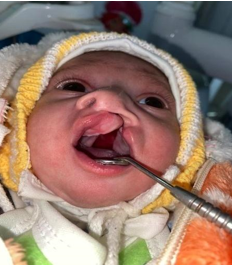
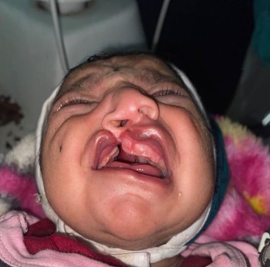
The patient along with one of the parents was seated facing forwardly in the dental chair. Keeping the position of the head upright, maxillary impressions were made out of fast-setting putty impression material (vinyl poly-siloxane) by loading it on to the fingers and adequately adapting upon the areas of the cleft and recording the details. [[Figure 3], [Figure 4] ]. The impressions were poured using type III dental stone [[Figure 6], [Figure 7]].


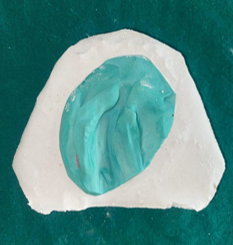
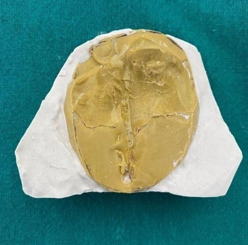
The Feeding obturators were fabricated using clear, flexible thermoforming material using thermoforming machine. An extraoral extension was made to secure the plate using a silk thread for safe handling and preventing any incidental swallowing into the oral cavity. Obturators were inserted for the neonates [[Figure 7], [Figure 8]] and parents instructions were given about its placement and cleaning after every use.
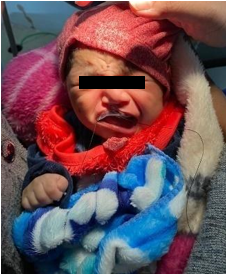

Discussion
Cleft lip and palate is a common inborn anomaly. Treatment of this malformation is an issue over year throughout the world. These cleft can involve other regions of orofacial complex, can be unilateral or bilateral or a combination. Out of all the cleft patients, together cleft lip and palate are seen 50%, followed by unilateral cleft palate which is 30%, and then the isolated cleft lip as 20%. Out of unilateral clefts, left side clefts are 70%. [2]
The newborn with cleft lip has almost akin feeding demand as neonate born without it, unless systemic problems are present. The prime concern for the initial period after the birth is proper nutrition for babies. [7] Feeding problems that are often seen with cleft patients that include nasal regurgitation, poor suction, more air intake, recurrent burping, and extended time for feeding. [8]
For Feeding obturator, acrylic resin is most frequently used material, although it is hard on tissues, chances of trauma to infant and need lot of patient’s visits. Therefore for our patients we preferred a single step thermoplastic material for the making of obturator which is soft, clear, and flexible. By keeping in view the need of feeding for an infant, the plate was delivered the same day and required instructions were given to parents. The prosthetic rehabilitation by flexible plate is a suitable option for newborns with cleft until the time of surgical closure of cleft or until new ways of intrauterine fetal cleft closure using endoscopic approach are well set. [9]
Conclusion
Adequate nourishment is essential for growth and development of an infant. Inadequate feeding affects growth and it leads to stress and anxiety in parents. [5]
Thus, a successful rehabilitation of Cleft lip and palate in neonates were achieved with flexible and soft feeding appliance. A treatment that reduced the apprehension of the parent’s and provided infant a good suction around nipple which improvised feeding efficiency.
Conflict of Interest
The authors declare no relevant conflicts of interest.
Source of Funding
None.
References
- Chandna P, Adlakha VK, Singh N. Feeding obturator appliance for an infant with cleft lip and palate. J Indian Soc Pedod Prev Dent. 2011;29(1):71-3. [Google Scholar] [Crossref]
- Dean J, Avery D, Mcdonald R. Dentistry for the Child and Adolescent. . 2011. [Google Scholar]
- Suri S, Utreja A. Institutional Approach in the Management of Cleft Lip and Palate . . 2000-2001. [Google Scholar]
- Goldberg W, Ferguson F, Miles R. Successful use of a feeding obturator for an infant with a cleft palate. Spec Care Dent. 1988;8(2):86-9. [Google Scholar] [Crossref]
- Jayanna R, Kumar G, Ahuja V, Patel S, Qamar S. A feeding appliance for a newborn with Veau Type III cleft lip and palate: A case report. J Multidiscip Dent Res. 2021;6(2):59-62. [Google Scholar] [Crossref]
- Lodaya R, Dave A, Kunte S, Shah R. A Feeding appliance for a 2 day old neonate with cleft lip and palate: A case report. Int J Oral Health Med Res. 2017;3(6):86-9. [Google Scholar]
- Balluff MA. Nutritional needs of an infant or child with a cleft lip or palate. Ear Nose Throat J. 1986;65(7):311-5. [Google Scholar]
- Goswami M, Jangra B, Bhushan U. Management of feeding problem in a patient with cleft lip/palate. Int J Clin Pediatr Dent. 2016;9(2):143-5. [Google Scholar] [Crossref]
- Rathee M. Single Visit Feeding Appliance for 1-day-old Neonate with Cleft Palate Using Safe Dental Putty-Gauze Hybrid Impression Technique for Maxillary Impression. J Surg Tech Case Rep. 2015;7(1):7-11. [Google Scholar]
How to Cite This Article
Vancouver
Barjatya K, Modi M, Masih U, Chand BR, Manker A, Juneja P. Flexible obturator in neonates with unilateral cleft lip and palate: Two case reports [Internet]. IP Ann Prosthodont Restor Dent. 2022 [cited 2025 Nov 07];8(2):112-115. Available from: https://doi.org/10.18231/j.aprd.2022.022
APA
Barjatya, K., Modi, M., Masih, U., Chand, B. R., Manker, A., Juneja, P. (2022). Flexible obturator in neonates with unilateral cleft lip and palate: Two case reports. IP Ann Prosthodont Restor Dent, 8(2), 112-115. https://doi.org/10.18231/j.aprd.2022.022
MLA
Barjatya, Khushboo, Modi, Meenal, Masih, Updesh, Chand, Binti Rani, Manker, Abhilasha, Juneja, Preene. "Flexible obturator in neonates with unilateral cleft lip and palate: Two case reports." IP Ann Prosthodont Restor Dent, vol. 8, no. 2, 2022, pp. 112-115. https://doi.org/10.18231/j.aprd.2022.022
Chicago
Barjatya, K., Modi, M., Masih, U., Chand, B. R., Manker, A., Juneja, P.. "Flexible obturator in neonates with unilateral cleft lip and palate: Two case reports." IP Ann Prosthodont Restor Dent 8, no. 2 (2022): 112-115. https://doi.org/10.18231/j.aprd.2022.022
